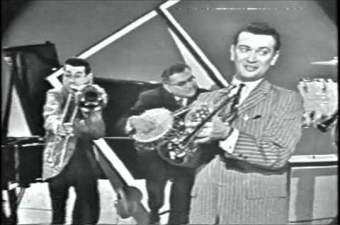Famous Door
339 Bourbon StreetNew Orleans LA 70130
Hypolite “Hyp” Guinle, a boxing promoter, opened the Famous Door in 1936, naming the place after the swanky Manhattan night spot that New Orleanian Louis Prima had put on the map. Billed as the “Jazz Corner of America,” Guinle’s Famous Door at Bourbon and Conti played an important role in the midcentury traditional jazz revival.
Around 1948, Joseph “Sharkey” Bonano and his Kings of Dixieland took a residency here. Bonano, an Italian-American from Milneburg in New Orleans, had toured the world playing trumpet in the 1920s and 30s. Like Louis Prima, with whom he briefly led a band, he was a charismatic front man, joking and dancing in his signature bowler hat. Bonano found an enthusiastic audience at the Famous Door, which led to radio and television appearances that helped reignite interest in New Orleans-style jazz.
Among Bonano’s admirers was a group of teenaged musicians led by brothers Fred and Frank Assunto. When their hero took his Kings of Dixieland on the road at the end of 1950, they filled his slot at the Famous Door as the Dukes of Dixieland. The group, which for a time featured a young Pete Fountain on clarinet, was so popular they kept the gig for nearly four years. Like Bonano, they parlayed the exposure into record deals and bookings around the country, including a long stint in Las Vegas and appearances from Carnegie Hall to the Ed Sullivan Show, further amplifying the New Orleans sound.
Another Dixieland bandleader, Murphy Campo, hired a youngster named Mac Rebennack to play upright bass at the Famous Door around 1961. Rebennack, who played up and down Bourbon Street before he became known as Dr. John, had recently been shot point-blank in his left ring finger. The wound opened as he played, and at the end of every night he had to clean blood off of the bass he borrowed to make the gig. He didn’t care much for Campo’s sound, and eventually split to Poodle’s Patio down the street.
In Hyp Guinle’s time the term “Dixieland” often referred to white bands playing in a style derived from New Orleans’ Black jazz pioneers. At the Famous Door, the term’s racial overtones were clear: The Kings and Dukes were white, the décor included a Confederate flag, and postcards from the club depicted a Black person sleeping on a bale of cotton.
Sharkey Bonano often danced onstage with Bourbon Street fixtures Oliver Anderson and Isaac Mason, a duo known as Pork Chop (or Pork Chops) and Kidney Stew. While local Black artists from Danny Barker to Lionel Batiste praised them as performers, their act included some racially stereotyped elements carried over from the vaudeville era.
The Famous Door also employed some Black musicians, including the blues singer Cousin Joe, also known as Smilin’ Joe, and the nationally renowned drummer June Gardner. Gardner, who played behind Sam Cooke and Lee Dorsey in the heyday of R&B, led a traditional jazz band here in the 1970s.
These days the label “Dixieland” has largely been retired, and the Famous Door—under different ownership—presents cover bands playing pop hits.
About Bourbon Street
Bourbon Street, one of the most famous streets in the country, is only 14 blocks long, running through the middle of the French Quarter. It took off as an entertainment district in the 1940s, when wartime activity brought waves of visitors to New Orleans. Bands often performed in floor shows featuring burlesque dancers (who stripped to varying degrees), comedians, and other entertainers.
This freewheeling era came to a close, in the eyes of many patrons, with District Attorney Jim Garrison’s vice raids in the early 1960s. Crime — organized and not — was pervasive on Bourbon Street, and Garrison’s crusade scored some political points. The resulting loss of revenue at the clubs, meanwhile, scaled back entertainment budgets.
The only black people on Bourbon Street at the time were there to work (musicians were generally considered hired help; some had to wait in storerooms between sets). Even after the passage of civil rights legislation some clubs resisted integration, and audiences on Bourbon Street remained largely white for years afterward.
In recent decades, as the city relied increasingly on tourism to prop up its economy, the market dictated more changes: Modern stripping supplanted burlesque and DJ booths replaced bandstands. The street became a pedestrian mall, filled with go-cups and Mardi Gras beads year-round. Several clubs sticking with live music offered low wages for bands to play songs familiar to visitors.
Hand-wringing about the quality and nature of live music on the strip has been more or less constant since the 1950s, and not without reason. Still, some venues persisted in hiring reputable artists. In the 2000s, the To Be Continued Brass Band took matters into their own hands, breaking into the scene by playing on the corner of Bourbon and Canal Street every night.
In any case millions of visitors to the strip each year find the spectacle they’re looking for, exotic but approachable, with a more permissive atmosphere than they feel at home. Its economic impact on the city is in the billions. If it’s crass it’s also egalitarian: Bourbon Street today is among the more integrated spaces in town.
Videos

In 1958, WNTA-TV filmed "New Orleans Jazz Party" at the WDSU-TV studio in New Orleans. Sharkey Bonano takes center stage at 1:27.
Video posted by Hoffmann Jazz.
In 1958, WNTA-TV filmed "New Orleans Jazz Party" at the WDSU-TV studio in New Orleans. Sharkey Bonano takes center stage at 1:27.

In 1958, Ed Sullivan recounted meeting the Assunto Brothers at the Famous Door and introduced the Dukes of Dixieland as "the number one jazz combo in the country."
Video posted by Deano Assunto.
In 1958, Ed Sullivan recounted meeting the Assunto Brothers at the Famous Door and introduced the Dukes of Dixieland as "the number one jazz combo in the country."
Images


























